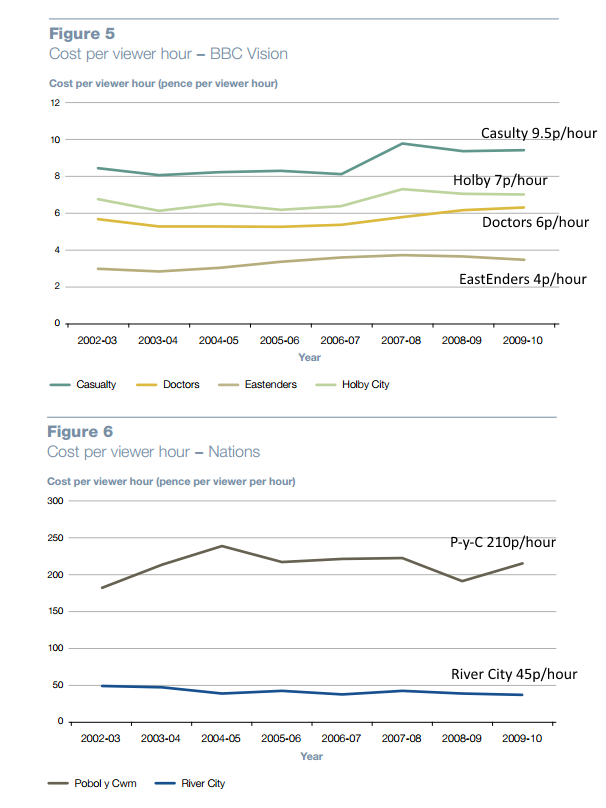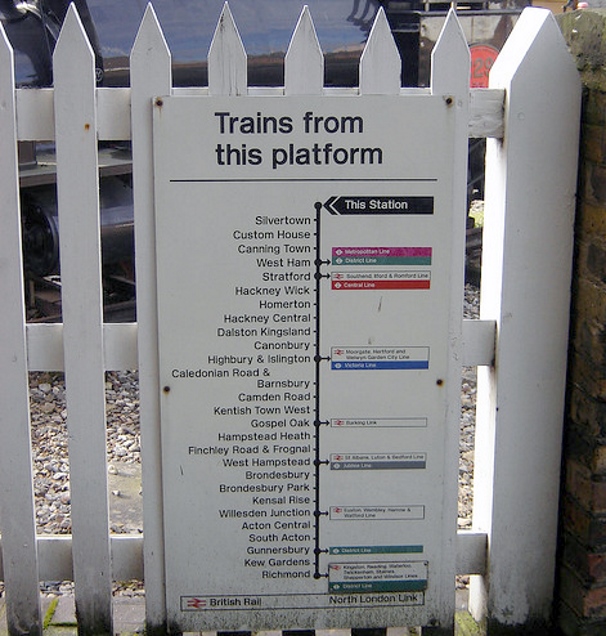News
TV
Freeview
Freesat
Maps
Radio
Help!
Archive (2002-)
All posts by Briantist
Below are all of Briantist's postings, with the most recent are at the bottom of the page.Andy: That's because there isn't an ITV Wales HD to broadcast, so you get Central West.
| link to this comment |
KMJ,Derby: It is interesting that in the BBC review of Drama costs, "River City" has one of the highest costs per viewer of any BBC programme, because it has high costs but only shown to 9% of the BBC One network.
The BBC’s "Management of the costs of producing continuing drama"[1] shows on page 18

[1] http://www.bbc.co.uk/bbct….pdf .
| link to this comment |
Can I just say that I'm sorry to everyone who uses Barnehurst, Barnes Bridge, Battersea Park, Bexleyheath, Bowes Park, Caterham, Cheam, Chelsfield, Chelsfield, Chipstead, Chiswick, Coulsdon South, Crews Hill, Dagenham Dock, Deptford, Eltham, Enfield Chase, Ewell East, Falconwood, Feltham, Gipsy Hill, Gordon Hill, Grange Park, Hither Green, Hither Green, Kenley, Kew Bridge, Kidbrooke, Kingswood, Knockholt, Knockholt, Maze Hill, Norbury, Palmers Green, Purley, Purley Oaks, Queenstown Road Battersea, Rainham, Reedham, Riddlesdown, Sanderstead, Selhurst, Smitham, St Johns, Streatham Common, Streatham Hill, Tadworth, Tattenham Corner, Thornton Heath, Upper Warlingham, Welling, West Norwood, Westcombe Park, Whitton, Whyteleafe, Whyteleafe South, Winchmore Hill and Woodmansterne stations in that they are not run by TfL and so don't appear on the Tube Map.
| link to this comment |
Final map thoughts
On my way back from the gym this morning I had some final thoughts, so I thought I would share these with you. These are more in the way of a brain-dump, rather than a sophisticated final treatises.
I guess the first thought is that I might not have actually done through the process if I had known what was involved. Yes, it was lovely to see the map on the BBC News last week and to have thousands of people "like" it on Facebook, but you are certainly setting yourself up for a lot of brainwork. When some people said I was "mad", I think I know what they were getting at.
The work aside, I have very much enjoyed having access to the specialist knowledge on the wonderful London Reconnections site. I am very proud that they supported my work and I really hope it makes the site more popular.
There have been a number of people who wished that I had started with a different map, or a totally different map altogether. Some people have expressed their like for geographically "correct" maps - even though there are huge issues here due to all maps being flat "projections" of a section of a globe - and others see a conspiracy against where they live due to the historical development of our capital city.

Google's map of the lines geographically "correct"
It is often said that Harry Beck got his inspiration for his map from electronic circuit design, but it seems likely to me that he would have known about the Seven Bridges of Konigsberg and the work of Leonhard Euler (1707-83). Beck insight was that the general public would understand the diagram he produced. It is to the great credit to those working at the London Underground to realise that they have a work of genius on their hands.
Try as they might, as many have, no-one has come up with anything better. Yes, they have tinkered and tried things out, but in a world of free ideas and easy computer aided design, the "keep it simple stupid" (KISS) of Beck's design still wins.
My changes are but tinkering, as is right. Bigger font for the most used "gateway and destination" station seems to have gone down well. The river Lea, much liked. The M25, no one has demanded the removal. Light Orange for the R25, bright pink for HS1, seems OK. I use some "off page markers" of arrows and dots. Grey text for outside Greater London, works OK. Selected interstation walking distances, much liked. Stealing the Waterloo and City's colours for HS2 and recoloring W&C. Thin green line for the trams. Dotted yellow for CR3.
It's actually quite odd to stand and compare this map now with the original. I was doing that yesterday at Startford DLR as I waiting for my 100% reliable transport (it says on the posters).
When I started, the Crossrail lines "weaved and bobbed" around the map. I have moved most of the elements on the map to provide these high-speed, high-capacity lines as straight lines. Harold Wood to Whitechapel is a single diagonal line, West Drayton to Paddington a straight horizontal, and the CR1 line crosses the centre with the minimum of fuss. CR2 is a little less straight that I would have wanted but I didn't want to change the familiar "inside the circle line" centre of the map at all.
I did change the King's Cross to Finsbury Park corridor into a single, strong diagonal, and the map is clearer for it. The only thing that I'm not happy about is I really wanted Manor House to be below the Overground.
There are so many changes from the original, some are subtle (the City Branch of the Northern Line is slightly shifted, Beckton has moved up a little) and some large (Barking has moved to stretch out the Hammersmith and City Line so Barking Riverside isn't too far away, the Central Line's Hainault loop is a lot different).
People are correct to point out that a "tube map" would probably not have Thameslink or the Northern City Line but they were necessary to understand the report properly and the do add to the understanding.
This map needed the combination of several skills. I have been using CorelDraw X6 (16), a software package I have used since version 2! Such familiarly with software makes it possible to do things as you conceive them, which is useful.
I suspect that my long-lost qualification in "Engineering Drawing" might have been helpful, as well as an A-Level Physics that encompassed electronics.
Another skill is that of graphic design. There is a lot to understand in the design, the elements, how they combine and the constraints. The font is "London Tube" a copyright-free version of the official one. The colours are as specified publically (as "Pantone colours") by LRT. I stuck to a limited set of symbols: the "station tick", the "national rail symbol", the "line end" symbol, "blue wheelchair guy" and "white wheelchair guy", two types of "station interchange" the long one and a short one.
The lines are all either horizontal, vertical or 45 degrees. I kept the curves where they were on the original map and also the line bend style. All the lines are the same width. I did my best to always keep station names on a single line, but where this was not possible they all have the same line spacing.
Another skill needed was that of research. Aside from starting with the existing 2014 Tube Map, and the much mentioned (by me) LONDON INFRASTRUCTURE PLAN 2050: TRANSPORT SUPPORTING PAPER, I have had to cross reference the information in this with other documents.
Such publications cover topics from the redevelopment of Brent Cross, the upgrade of the Croydon Tram system, research by Bromley Council, plans for HS2, reports into Barking Riverside, Old Kent Road redevelopment, the Lea Valley Development plans, the STAR (Stratford to Angel Road) proposals, the detailed Crossrail 2 2013 documents (for the proposal of South Tottenham being linked), 2014 CR2 documents (for the Stoke Newington and Clapton stations), DfT documents decising which London railways get transferred to TfL (Chingford line yes, Enfield Town line, yes, Tottenham Hale Lea Valley line, no, Upminster to Romford "shunt" yes, everything else, no).
I'm so very grateful to carto.metro.free.fr Detailled London transport map (track, depot, ...) for the detailed track plans, and of course to Google Maps. Also abandonedstations.org.uk and disused-stations.org.uk for being inspritational - see the Interactive map of closed and proposed London Underground, Overground stations of them.
I've also had to read up on a lot of policy issues I was only half aware of, in particular what constitutes "step free access" and why it is important.
The last thing I should mention is that the map has inspired me to take a few train trips to places I haven't been before, such as Bromley and Epping. I went to Bethnal Green to walk from Line to Line. And I can say that I have visited every DLR station now. Who know, I might nip down to Croydon for a quick tram ride?
So, to conclude.
I have spent many years reading books about the underground history. "Rails Through the Clay: A History of London's Tube Railways" (Jackson and Croome, 1993) and "London Under London: A Subterranean Guide" (Trench and Hillman 1993) being two of the best.
And I had one of those "poster books" of the underground map showing closed stations (and an apology for the cover being "defaced by a barcode").
It shows the complexity of the subject that even after all this time there are still stations you missed, viaducts you passed under or over but didn't take in.
There was a couple of guys on the DLR train I was on yesterday saying that "they didn't come this way much" and "it seems to have change a bit". Well, yes!
As I said before I recall being at North Woolwich station in the late 1980s seeing the signs for the North London Line and seeing this sign and thinking how sad it was that this marvellous service ran hourly.

Today, the service is regular. Richmond to Stratford is the popular Overground, the rest of the line has Jubilee Line trains every few minutes. And the DLR is there too.
So, yes, the Mayor's vision might be imperfect. But it's a vision and if this old sign proves anything is that when people can see something of the future, they want it.
So, please, one last time, take a look at the map I did ofthe Mayor's 2050 vision and hope that as before you get more than you could have ever hoped for
| link to this comment |
The channel should be back on Freesat and Sky very soon, according to Bonanza Bonanza network relaunches in the UK ? Digital TV Europe !
| link to this comment |
A bit of fun! Video: Commuter races London Underground train - and wins - Telegraph
| link to this comment |
william grierson: This being the internet and all, blue text means it's a link for you to click on should you wish to do so...
| link to this comment |
Kim Jones: In addition sharealam's comment, there are some +1 channels on Freeview ITV +1, ITV 2 +1, ITV 3+1, ITV 4 +1, Quest +1, Channel 5 +1, Movies4Men +1, truTV +1, but not of the Travel Channel.
| link to this comment |
Sunday 14 September 2014 6:45PM
Also, bonus materialm here is a Bromley Council plan for the Overground: